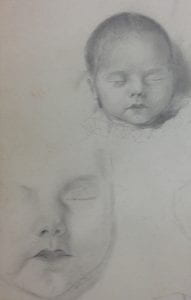Content Warning: This article contains a convict’s (non-graphic) drawing of a deceased child.
Imagine the prospect of having a resource with which to easily map and examine useful historical data from a period of great change. This describes a project that has recently received an ARC Linkage Grant and is headed by two UNE academics.
UNE’s Professor Hamish Maxwell-Stewart and Dr Richard Tuffin are both part of ‘Putting death in its place’ — a project that aims to examine the relationships between mortality, life expectancy, health and where people lived between 1838 and 1930 in Tasmania.
The inspiration for this project was first seeded when Professor Maxwell-Stewart and Dr Tuffin came across the annually printed Tasmanian valuation rolls. These rolls details when a property first appeared historically and give the name of the occupant as well as the name of the owner. These rolls exist for every property in the state from 1858 to 1960 and for slightly longer periods for Hobart and Launceston. The discovery of this information led to the realisation that it would not be difficult to turn these printed lists into digital files, and link the data to historical births, deaths and marriages. Thus the project was born.
Having accessible data from this period of time is rather significant from a historical perspective as the period from 1850 to 1960 saw notable changes. Professor Maxwell-Stewart notes that the most interesting aspects of this data is the “extent to which improvements in the built environment might explain rises in life expectance.”
Not only will this provide a better understanding of life expectance and its connection with infrastructure, this project will also result in a significant historical resource.
“An exciting outcome is that it will create the base line data for a historical atlas of Tasmania,” said Professor Maxwell-Stewart when describing the benefits of the project. “Eventually we hope to be able to trace every household — this will be a huge resource for family historians, heritage managers, academic researchers and perhaps even real estate agents. We also hope that the skills we develop will help us pull off similar tricks for other Australian records. Finally we will of course end up with the means to track the impacts of housing inequality across generations.”
However, creating the ground work for significant historical resources like this also takes time and expertise. Much of the project will consist of large quantities of data linkage, cleaning, coding and marking up of records. As Professor Maxwell-Stewart puts it “our field work will largely be done sitting down!”
A curious and unexpected key resource for this project will be the early 20th century Metropolitan Drainage Board plans. These depict Hobart in stunning detail, a high degree of accuracy which allows for geolocation enabling valuation data to be linked to households. Professor Maxwell-Stewart described another important benefit of these maps is that they “will be integral to understanding any relationship between infant mortality and sanitary arrangements over time. While we are not going to spend much time in the field proper, we will certainly be getting our hands dirty!”
While there is still much work to be done on this project, there have already been some insights throughout the research and mapping process.

Drawing of a deceased child by Thomas Bock c. 1850. Queen Victoria Museum and Art Gallery Launceston, Bock Sketchbook 2 post mortem studies.
“We are surprised at the number of women who held property. There were many female landlords for example. Another interesting issue is the large number of former convicts that we have been able to link to a valuation roll. This will help to flesh out the post-emancipation lives of convicts and lead to a more rounded assessment of outcomes for transported prisoners.”
Having an idea of the benefits of a project is one step in understanding where it can go next, the other is seeing what kind of learning comes from the process itself.
“The best way to view a project like this is that it is a bit like putting together a vast jigsaw,” said Professor Maxwell-Stewart. “As well as learning all kinds of tricks that can be applied to similar record groups elsewhere in Australia, there are many other pieces that could be added to our Tasmanian puzzle in the future. We have plans to link World War One enlistment records to the house of birth for example. As every soldier was measured and examined by a doctor on enlistment this would enable us to explore the impact of the built environment on the lived experience of 15,000 young adult Tasmanian men.”
Professor Maxwell-Stewart noted that there are plans in the Department of Archaeology, Classics and History to use project data in undergraduate and postgraduate teaching to further provide UNE students with excellent learning and research experiences.



Dear Hamish and Richard,
Sounds like a great project!
Do please add my details to any list of people, if there is one, that you will send updates/project findings to in the future. My family tree goes back to George Artis Lovett, sent out in 1830/31 for embezzlement. His son, William Lovett, went on to be Tasmania’s Colonial Auditor and Auditor General from 1873 to 1894 🙂
Cheers,
David Mackay (Ecosystem Management, UNE)
Hi David, yep we know George Lovett; arrived on the convict “John” in 1831, leaving behind a wife and 8 children!!
Sounds like you should come over to our side of the campus and research some History with us 🙂
cheers
David Roberts HASS
G’day David
We’ll make sure to put out regular(ish) stories. I’m in the midst of georeferencing the whole of Hobart in the 1890s-1900s, which will mean we can start working backwards to locate all our addresses. I am sure the Lovett’s will be in there somewhere…we’ll make sure to keep an eye out.
Cheers
Richard